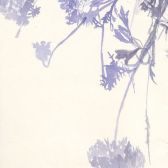Painted Shadows
As with many a discovery, I made this one almost quite by accident. It was not long before the end of summer term and I had taken a local primary school class to sketch in the Secondary School’s vegetable garden, which was maintained by a special needs class I also worked with. While some children were still busy painting away, one impatient boy asked me what he could do next. While searching for a subject, I noticed a nice plant shadow along the edge of the path and told the pupil to have a go at painting it. The result was so good that I promised myself to have a go as soon as I had some free time!
That was back in 2007 and I haven’t stopped painting shadows since then!
Painting (on) shadows is not just a case of tracing or copying. Natural shadows, be it from the sun or the moon, move surprisingly fast and the angle of the light source changes too. So we are dealing with moving, amorphous shapes. They can have depth and be coloured by transparence/translucence.
Many of my shadow paintings are in Indian ink, but I also work in artificial lighting and am making more coloured shadows in mixed media. Whether coloured or not, painting shadows requires very rapid (expressive) brushwork akin to that of traditional Asiatic calligraphy, and a firm knowledge of plant anatomy and structure.
Don’t forget, I had been illustrating plants in watercolour for 25 years before I started to tackle plant shadows! Looking at plants in the shade and imagining what kind of shadow they will produce is a great exercise in 3-D thinking!
I still teach some shadow painting as an exercise to help my students to develop and sharpen their ‘vision’:
“When you draw a shadow painting, you think of the plant or object that casts the shadow, the time of day, the quality of the light, the sun of course, your brush, your paper,
your ink or watercolour. How often do you consider the ground that holds so much of this together,
or out of which many of your materials grew? I believe in general we don't think too often of this…”
Béatrice Aw,
Workshop student, Luxembourg, 2012.
My shadow paintings were much appreciated in Japan. At an exhibition appreciation workshop on one of my shadow paintings, it was amazing to listen to what both children and adults “saw” in the painting.
“…The pieces I was most attracted to in the whole exhibition, so much so I ended up standing in front of the work(s) repeatedly - were the pair of drawings of grape vine leaves…
You told me you need good sunlight to have a good shadow.
Yes, you must have picked up the edge of the shadow on your sketchbook fallen from vine leaves, maybe looking down on the sketchbook, but for me, the drawings made me feel as if I was looking up the sky from under the vine leaves, maybe lying on the ground, in an early summer afternoon.
The sunshine I can see through the leaves is strong and shiny and so
the colour of leaves you can see is just black - but the leaves give
vine-leaf-shaped shadows on your face and I can almost feel the cool
soil on my back and light breeze...
That kind of feeling. And it was very, very relaxing moment.”
Keiko Nakajima,
Extract of an E-mail letter from a visitor to my exhibition in Tokyo, July 2010.











